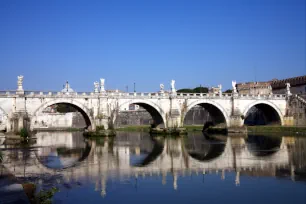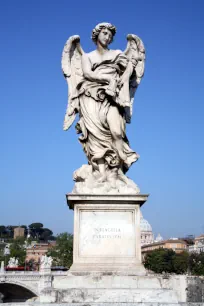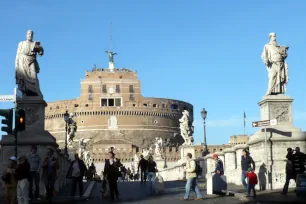Most people regard the Ponte Sant’Angelo as the most beautiful bridge in Rome. Its origin goes back to the second century AD; the famous statues of angels that flank the bridge were added in the seventeenth century.
Construction


In 136 AD, Emperor Hadrian ordered the construction of a new bridge over the Tiber River. The emperor wanted to connect his mausoleum – now the Castel Sant’Angelo – with the city of Rome across the river. The bridge was originally known as the Pons Aelius, after the gens (family name) of Hadrian, whose full name was Publius Aelius Hadrianus.
Bridge of the Holy Angel
After the construction of the St. Peter’s Basilica in the fourth century AD, the bridge became known as St. Peter’s Bridge, since it was on the main route towards the basilica. According to legend, an archangel appeared on top of the mausoleum in 590 AD. Since then, the bridge has been known as the Ponte Sant’Angelo (Bridge of the Holy Angel). Around the same time, the Mausoleum of Hadrian was renamed Castel Sant’Angelo (Castle of the Holy Angel). So while many people assume the bridge is named for the statues of angels on the bridge, the name in fact refers to the statue of the archangel which stands atop Castel Sant’Angelo.
The Statues


The ten statues of angels that adorn the bridge were added much later. They were designed in 1668 by the great sculptor Gian Lorenzo Bernini on the order of Pope Clement IX and created by Bernini and his students. The angels all hold a symbol of the crucifixion of Jesus, such as a crown of thorns, a whip, and so on.
Two of the statues were created by Bernini himself: the angel holding the Crown of Thorns and the angel holding the INRI sign. They were deemed too beautiful by the pope to stand outside, so Bernini’s students created replicas that were placed on the bridge instead. The originals are now in the church of Sant’Andrea delle Fratte, just south of the Spanish Steps.
At the south end of the bridge stand two more statues, of the apostles Peter and Paul. They were installed here in 1534 to replace two small chapels that were erected in the fifteenth century to commemorate the death of 172 pilgrims who died on the bridge in 1450 when a rider lost control of her horse and the balustrade collapsed under the weight of the panicking crowd. The statue of Peter was created by Lorenzetto; the statue of Paul is the work of Paolo Taccone.
The Bridge Today

The bridge’s three central arches are still the originals from the ancient Roman era. In the seventeenth century two more arches were added, one on either side, to replace the original ramps that lead to the bridge. The bridge was further modified in the nineteenth century when the Tiber embankment was built to protect the city from floodwater. Today, the bridge is pedestrianized; tourists pass here on their way to the Castel Sant’Angelo and the Vatican.
- Next: Mouth of Truth
- More Sights & Attractions in Rome

